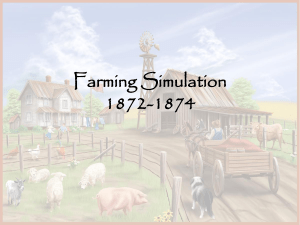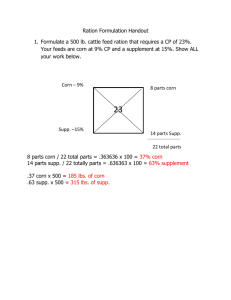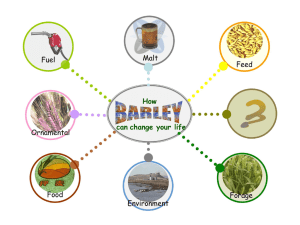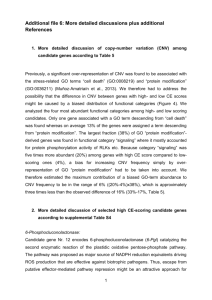Barley Outline for Breeding Program profiles
advertisement
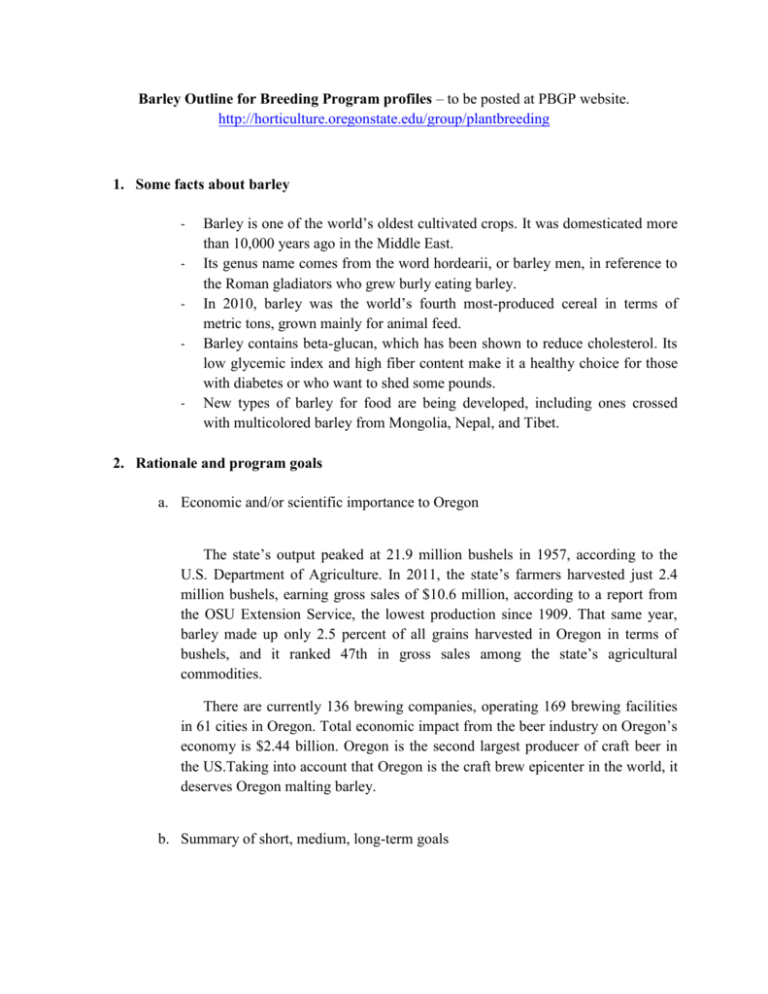
Barley Outline for Breeding Program profiles – to be posted at PBGP website. http://horticulture.oregonstate.edu/group/plantbreeding 1. Some facts about barley - - Barley is one of the world’s oldest cultivated crops. It was domesticated more than 10,000 years ago in the Middle East. Its genus name comes from the word hordearii, or barley men, in reference to the Roman gladiators who grew burly eating barley. In 2010, barley was the world’s fourth most-produced cereal in terms of metric tons, grown mainly for animal feed. Barley contains beta-glucan, which has been shown to reduce cholesterol. Its low glycemic index and high fiber content make it a healthy choice for those with diabetes or who want to shed some pounds. New types of barley for food are being developed, including ones crossed with multicolored barley from Mongolia, Nepal, and Tibet. 2. Rationale and program goals a. Economic and/or scientific importance to Oregon The state’s output peaked at 21.9 million bushels in 1957, according to the U.S. Department of Agriculture. In 2011, the state’s farmers harvested just 2.4 million bushels, earning gross sales of $10.6 million, according to a report from the OSU Extension Service, the lowest production since 1909. That same year, barley made up only 2.5 percent of all grains harvested in Oregon in terms of bushels, and it ranked 47th in gross sales among the state’s agricultural commodities. There are currently 136 brewing companies, operating 169 brewing facilities in 61 cities in Oregon. Total economic impact from the beer industry on Oregon’s economy is $2.44 billion. Oregon is the second largest producer of craft beer in the US.Taking into account that Oregon is the craft brew epicenter in the world, it deserves Oregon malting barley. b. Summary of short, medium, long-term goals - Evaluate thousands of different genetic crosses to see how well they resist disease, tolerate the cold, and perform in the kitchen and brewery. Estimate their yields, growing some of them organically, and seeing how much water and nitrogen they need. Highlight nutritional properties of barley and make consumers be aware of it. Keep robust and regular consumption. Diversify farmers’ crops with barley and cash in on a growing interest in microbrews and whole-grain diets. Obtain high-yielding grain that incorporates flavor, texture, and color to beer, food, and livestock feed. 3. Current Research Projects a. Focus Current research interests in the barley breeding program include: development of winter habit barley varieties for malting and human nutrition; the many facets of winter hardiness; dissection of quantitative disease resistance; characterization and utilization of genetic diversity; stimulating local barley production; and barley quality assessment. An important objective is developing barley that reflects the terroir—or soil and climate—of Oregon, much like wine grapes by seeing if genes influence the flavor of barley. b. Breeding method(s) - Doubled haploid production Single seed descent Molecular Marker Assistant Selection (MAS) c. Sponsors - Oregon Wheat commission funding Agricultural Research Foundation American Malting Barley Association Busch Agricultural Resources Great Western Malting Idaho Barley Commission New Glarus Brewing Sierra Nevada Brewing - USDA-ARS USDA-NIFA TriticeaeCAP d. Collaborators - Matt Kolding Chris Mundt Steve Petrie Andrew Ross Tom Shellhammer Dr. David Hole at Utah State University Dr. Kevin Smith at the University of Minnesota Dr. Xianming Chen at Washington State University Partnered research with countries that include Australia, Germany, Japan, Scotland, and Uruguay. 4. Graduate student training PI statement of expectations for grad students Graduate students require showing academic motivation, infinite curiosity, and hard working. Graduate students should have experience in field, greenhouse, and lab activities. It is expected that Master’s students publish one journal paper and PhD students two to three journal papers to pursue their respective degrees. Besides all these academic requirements, students need to have an astute, adventurous and can-do attitude all the time. a. Past and current grad student projects My research focuses on breeding novel varieties of food barley. The material that is currently in our advanced trials consists of Himalayan and European germplasm crossed with OSU adapted varieties. These trials are being grown at multiple locations over multiple years under different conditions including organic, conventional, irrigated, and dryland. I am characterizing our most advanced food lines for a number of cereal quality traits, including grain beta- glucan, grain protein, kernel hardness, flour quality, and a variety of nutritional traits. Many of these cereal chemistry tests have never been run with barley, so I am adapting protocol from wheat and rice. These advanced lines have also undergone informal sensory testing to determine if there is a difference in flavor, aroma, and texture. To promote the consumption of barley, I maintain a webpage to post information, recipes, and reports on food barley to reach out to local farmers, chefs, and anyone who is interested in eating barley. Brigid Meints I am conducting genome-wide association studies (GWAS) for nitrogen use efficiency, water use efficiency, disease resistance, yield components and malting quality using elite germplasm - a panel of 300 advanced lines (F6 or later generations) from the Oregon State University and University of Minnesota winter and facultative 6-row barley breeding programs. Part of my project involves indirect assessment of various traits (especially nitrogen and water use efficiencies) via canopy spectral reflectance. Araby Belcher For my master's degree, I've focused on the contributions barley can make to beer flavor. To do this, we selected a set of 114 barley landraces and cultivars from the NSGS World Core collection for barley, which are being used to make wort at Sierra Nevada Brewing Company (wort is a precursor to beer). Each wort will undergo sensory analysis to determine if specific barley varieties can contribute positive flavors to the wort, and which varieties do so. If this is a success, we hope to identify the genes responsible for positive flavors, and introgress them into modern malting varieties to make better beer. Currently, Bells, Firestone, New Glarus, Russian River, Sierra Nevada, and Summit are all supporting my research both financially and through their expertise in brewing. Ryan Graebner 5. Products a. List of publications 1. Castro, A., F. Gamba, S. German, S. Gonzales, P.M. Hayes, S. Pereyra, C. Perez. 2012. QTL analysis of spot blotch and leaf rust resistance in the BCD47 x Baronesse barley mapping population. Plant Breeding. 13: 258- 2. 3. 4. 5. 266. Blake, V.C., J. Kling, P.M. Hayes, J.L. Jannink, S. R. Jillella, J. Lee, D. E. Matthews, S. Chao, T.J. Close, G.J. Muehlbauer, K. P. Smith, R.P. Wise, J.A. Dickerson. 2012. The Hordeum Toolbox: the Barley Coordinated Agricultural Project genotype and phenotype resource. The Plant Genome. 5:81-91. Fisk, S.P., A. Cuesta-Marcos, L. Cistué, J. Russell, K.P. Smith, P.S. Baenziger, Z. Bedo, A. Corey, T. Filichkin, I. Karsai, R. Waugh and P.M. Hayes. 2013. FR-H3: A new QTL to assist in the development of fall-sown barley with superior low temperature tolerance. Theor. Appl. Genet. 126:33 5–347 Locatelli, A. A. Cuesta-Marcos, L. Gutiérrez, P.M. Hayes, K.P. Smith, and A. Castro. 2013. Genome-wide association mapping of agronomic traits in relevant barley germplasm in Uruguay. Mol. Breeding. In press. Haggard, K. G., N. S. Geiger, P. M. Hayes, and A. J. Milligan. 2013. Suppression of cyanobacterial growth of Aphanizomenon flos-aquae by vascular plant decomposition products in Upper Klamath Lake, Oregon. Lake Reserv. Manag. 29: 13-22. b. Varieties released 1. Maranna (spring 6-row feed) 1993 2. Kold (winter 6-row feed) 1996 3. Strider (winter 6-row feed) 1997 4. Orca (spring 2-row feed) 1998 5. Tango (spring 6-row feed) 2000 6. Sara (spring 6-row forage) 2002 7. Maja (winter 6-row feed/malt) 2007 8. Verdant (winter 6-row forage) 2011 9. Alba (winter 6-row feed) 2012 10. Streaker (winter 6-row food) pending 6. Image gallery Barley plants Two-row and six-row barley Barley bread Barley beer Barley stripe rust lesion Water use efficiency final irrigation Infrared thermometer for canopy temperature depression Barley Bundles

